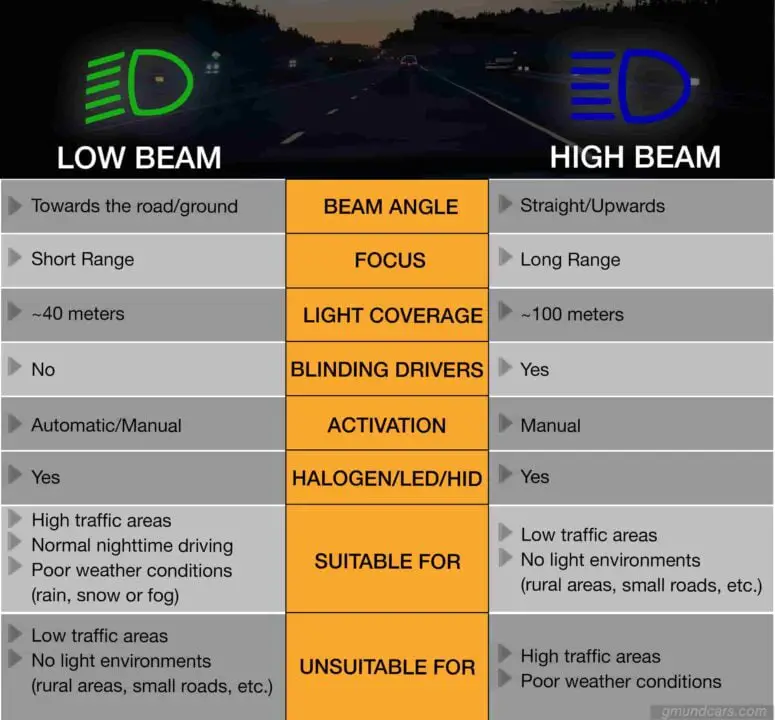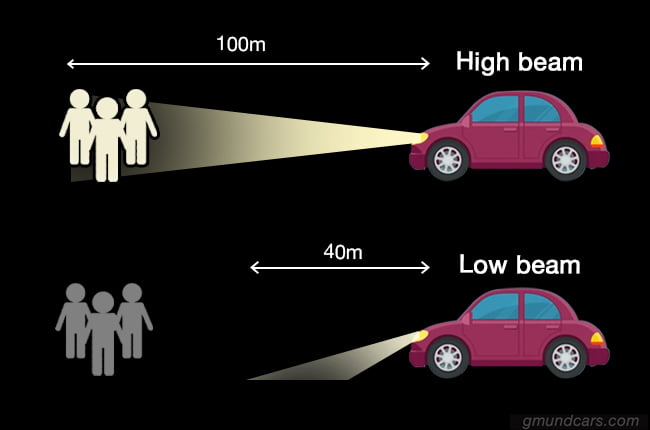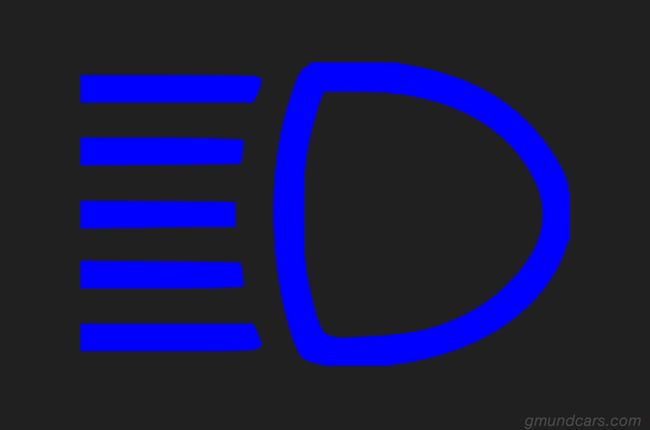Don’t think it strange. Let me clarify the reason by equipping you with:
- Differences between low beams and high beams
- When to use them
- Some problems with each type
Let’s dive right in.
Low beam vs. high beam – Key differences?
The table below illustrates the primary differences between a low beam and a high beam setting:

When it comes to low beam and high beam, they play vital roles in lighting your way in the right ways.
While the rays from the low beam point towards the ground, those from the high beam come in another direction. The high beam will light straight along the road in the very long range. On the contrary, the low beam only shines the road in a short range.
Let’s take a look at the image below. Imagine you are going for a stroll with two of your friends on the street and a car is approaching. Even though the car is far away from you for about 100 meters, it still shines the three of you brightly and makes you all blinded. In this case, it means that the car is turning on its high beam.
In another scenario, although you still hear the car driving towards you and it is only away from you for 40 meters, it doesn’t blind you at all. What you and your friends can see is all rays angling towards the road. Now, you can know what beam the car driver is turning on. Yes, that’s the low beam.

For old cars, drivers have to switch on their low beams in a manual way when they are in locations where the low beam is necessary. Meanwhile, with the developing technology, newer cars have become more “intelligent”. They can detect the environments where there is low light and turn on the low beam automatically. This is different from high beams. You always have to manually switch them on when they are indispensable.
Gone are the days when all of the cars had separate bulbs with separate high beams and low beams. Nowadays, a single bulb in most modern vehicles boasts two filaments – one for low beams and another for high beams. However, I only say “most” because some types of cars (especially for higher-end vehicles or performance vehicles) still own different bulbs for two types of beams. Halogen, LED, and HID headlights have low and high beams. And choosing the best bulb among these three headlight bulbs will make these beams even brighter.
What are low beams?
Low beams are the headlight settings that light up only a small area ahead of your car, about 40 meters. Despite the limited radiation, they become useful in some cases. Read on to find out those benefits.

Best Halogen – Low Beam

Best LED – Low Beam
Low beam symbol
Once you switch on your low beam headlights, the following symbol will appear on the dashboard:

The low beam symbol has its rays pointing downwards. Low beams point towards the ground more than they point forward. It is different from the high beam symbol, as you will see later on in this article.
When to use low beams
They are most suited for driving at night where there is heavy traffic. Driving experts also recommend using a low beam headlight setting in properly lit cities. Also, it would be best if you also don’t use them when travelling on highways without much traffic.
Besides, low beams are ideal for driving in rainy, foggy, or snowy conditions. Ideal? You are likely thinking that I’m wrong because high beams are more appropriate for these situations, which need more light and further illumination. But, I say “No, no, and no”. It’s better to have low beams on.
Believe me! Because they will provide better visibility compared to using high beams. Why? Let’s find the reason below.
What are high beams?
High beams produce a brighter light than low beams. They light up more than 100 meters ahead of your vehicle.

Best Halogen – High Beam

Best LED – High Beam
High beam symbol
High beams light at the very far point towards the front than to the ground. This symbol is what you’ll find on your dashboard whenever you switch to a high beam mode. Note the difference between the high beam and low beam symbols:

The symbol has its rays pointing straight as opposed to the low beam symbol illustrated above.
When to use high beams
Regarding high beams, the regulation depends on each state. You are requested to have your high beams dimmed within a specific distance. When your car approaches traffic or follows another car, the distances also differ.
Listed below are some states with their own regulations on high beams. When you drive within these distances when approaching traffic or following another car, remember to switch to low beams.
| State | When approaching traffic | When following another vehicle |
|---|---|---|
| Alabama | 500 feet | 200 feet |
| Alaska | 500 feet | 500 feet |
| Arizona | 500 feet | 200 feet |
| Arkansas | 500 feet | 200 feet |
| Colorado | 500 feet | 200 feet |
| Connecticut | 500 feet | 300 feet |
| Delaware | 500 feet | 200 feet |
| District of Columbia | 500 feet | 300 feet |
| Florida | 500 feet | 300 feet |
| Georgia | 500 feet | 200 feet |
| Idaho | 500 feet | 200 feet |
| Illinois | 500 feet | 300 feet |
| Indiana | 500 feet | 200 feet |
| Iowa | 1000 feet | 400 feet |
| Kentucky | 500 feet | 200 feet |
| Louisiana | 500 feet | 200 feet |
| Maine | 500 feet | 300 feet |
| Maryland | 500 feet | 300 feet |
| Massachusetts | 500 feet | 200 feet |
| Michigan | 1000 feet | 200 feet |
| Minnesota | 1000 feet | 200 feet |
| Missouri | 500 feet | 300 feet |
| Montana | 1000 feet | 500 feet |
| Nevada | 500 feet | 300 feet |
| New Mexico | 500 feet | 200 feet |
| New York | 500 feet | 200 feet |
| North Dakota | 500 feet | 300 feet |
| Oklahoma | 1000 feet | 600 feet |
| Oregon | 500 feet | 350 feet |
| Pennsylvania | 500 feet | 300 feet |
| Rhode Island | 500 feet | 200 feet |
| South Carolina | 500 feet | 200 feet |
| Tennessee | 500 feet | 500 feet |
| Texas | 500 feet | 300 feet |
| Utah | 500 feet | 300 feet |
| Virginia | 500 feet | 200 feet |
| West Virginia | 500 feet | 200 feet |
| Wisconsin | 500 feet | 500 feet |
It is recommended that you use high beams where there are few other vehicles on the road. High beams can light up to 100 meters ahead of your vehicle. When approaching another vehicle, you need to switch to a low beam to avoid blinding other drivers. Low beams should also be best used in low-traffic areas, e.g., rural areas and small roads.
It’s true that:
Roads can be the most ruthless places on earth. You’ve probably come across an arrogant driver who does not want to switch to a low beam as you approach each other. You can handle such drivers by avoiding looking at their vehicles directly – they’ll blind you. One way is that you can look toward the right edge of your lane.
Now, you may be wondering:
“If a high beam produces more light than a low beam, why shouldn’t I use it when driving in dense foggy, rainy, or snowy conditions?”
Here’s why:
Fog is made of cloud particles. Now, because high beams produce a lot of light pointed forward, the cloud particles will reflect the light. The light then reflects at you, creating a glare. Rain and snow will also happen in similar situations. Therefore, all you need to do when driving under those conditions is to turn on your low beams for your safety.
Why your low beam doesn’t work while your high beam does
Now, there are some occasions that you’ll find your low beams stop working. Here are the reasons why that may happen:
- Your headlight’s socket may be corroded – This means that it blocks a significant amount of light produced by your bulb. You can use a contact cleaner to do away with this condition. It is available in auto parts shops. However, if the corrosion is dense, you can use a small wire brush to scrape it off.
- Compromised headlight wiring – check and replace it.
- Broken headlight switches – The best way to solve this problem is by replacing them.
- Bad fuse or relay – You need to replace the bad fuse or relay to get your vehicle going again.
- Worn-out headlights – all headlights require replacement after a significant amount of usage over time.
Why your high beam doesn’t work while your low beam does
At times, you’ll find out that your low beams fail to work. Let’s find the reasons below:
- Blown bulb – all bulbs eventually get blown. They have a working lifespan of up to 1000 hours. Once your bulb blows out, you’ll need to replace it.
- Blown fuse – The high beam fuse may get blown, which will undoubtedly affect your high beam functionality. You should replace the blown fuse. It’ll last longer and serve you better.
- Faulty relay – There is no other way to solve this problem apart from replacing it with an original part.
- Wiring issues – They may be due to corroded wires. It’s time to have them replaced.
- Using the wrong type of bulb for your headlight certainly brings high beam problems. You’ll not be able to see clearly. Therefore, you need to use the right type of bulb for better visibility.
Final thoughts
Both the low and high beam settings in your car are essential, especially when you know where and when to use either of them correctly.
How you choose to use either of the two settings is up to you – but it comes with a responsibility. Safety should be the primary responsibility of any driver. You need to ensure that both the high and low beams are functioning correctly.
Remember to engage the low beam setting when approaching on-coming traffic. Do not let your laziness make fellow travelers irritated.